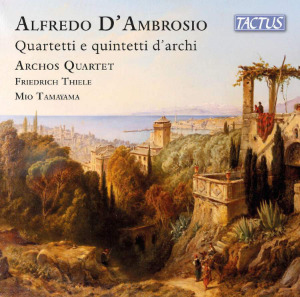
Alfredo d’Ambrosio (1871-1914)
Suite for string quintet, Op.8 (1900)
String Quartet, Op.42 (1908)
En Badinant (1896)
Valse intermède; from Premières Tendresses (1896 arr 1922)
Pavane (1911)
Rêve (1898)
Archos Quartet
Friedrich Thiele (cello II), Mio Tamayama (bass)
rec. 2022, Vogtlandhalle, Greiz, Germany
Tactus TC870401 [72]
Times have never been better for the admirer of the art of Neapolitan violinist and composer Alfredo d’Ambrosio. As I’ve written before, but in the interests of meeting the curiosity of those interested in his art, back in 2019 I reviewed DVD performances of the two concertos, whilst there’s also a 2022 DVD of smaller pieces dedicated to d’Ambrosio’s eminent contemporaries (review). More recently still, Brilliant brought out a 3-CD set of all d’Ambrosio’s smaller pieces (review) played by the Gran Duo Italiano. The latest release I covered was a rather disappointing coupling of his violin concertos (review).
Now here’s something of a novelty, a small chamber selection for string quartet and string quintet. The Suite for string quintet, with the second cello played by Friedrich Thiele, was composed in 1900 and is suffused with d’Ambrosio’s fulsome and mellifluous lyricism. Though he’s one of the most easy-going of executant composers, perfectly gauging his violin sweetmeats for performance, in this larger scaled work, too, he hits the right note. Listen to the boulevardier confidence of the Scherzo, laced with pizzicati and ripe staccati, for example. I agree with the booklet note writer that the third movement Berceuse is somewhat unexpected in its cradle song appeal though its warmly textured and richly romanticised profile should come as no surprise to the aficionado of the composer. Quietly Slavic in places, the finale is the longest movement and is fluidly done, managing a confident close with no little aplomb. The Archos Quartet play the Suite with accomplished warmth; they’ve already recorded Sinigaglia’s quartet works and are no strangers to generous-hearted Italian chamber works.
The four-movement String Quartet appeared in 1908 and is similarly sized as the Suite, though a touch more developed, lasting around 29 minutes. This owes quite a bit to Dvořák who had died a few years earlier. It’s not solely in its folkloric elements that this allegiance is apparent but in its rhythms and general affiliations that haunt the first two movements – beneficially, I should add. The slow movement is a warm lied, and the finale crisp, rhythmically incisive and showing good control of slower reflective material. I can’t, hand on heart, say that much of this is particularly distinctive but it’s typical of d’Ambrosio that he is incapable of curt gestures or rough edges. He’s the Amaretto of petit-maître composers of the time, sweet and succulent – a man who lives and composes in everlasting springtime.
The four brief pieces that end the disc are written for string quartet and double bass (Mio Tamayama). These charmers are more obviously typical of d’Ambrosio’s violin-orientated character pieces, from the terpsichorean delights of En Badinant to the café-scaled exchanges of the Valse intermède – edited after d’Ambrosio’s death from a piece for solo piano – to the sweeter blandishments of the quasi-impressionistic Gallicisms of the Pavane.
The performances, recording, and documentation are all splendid and do justice to his limited but immensely likeable art.
Jonathan Woolf
Help us financially by purchasing from





















